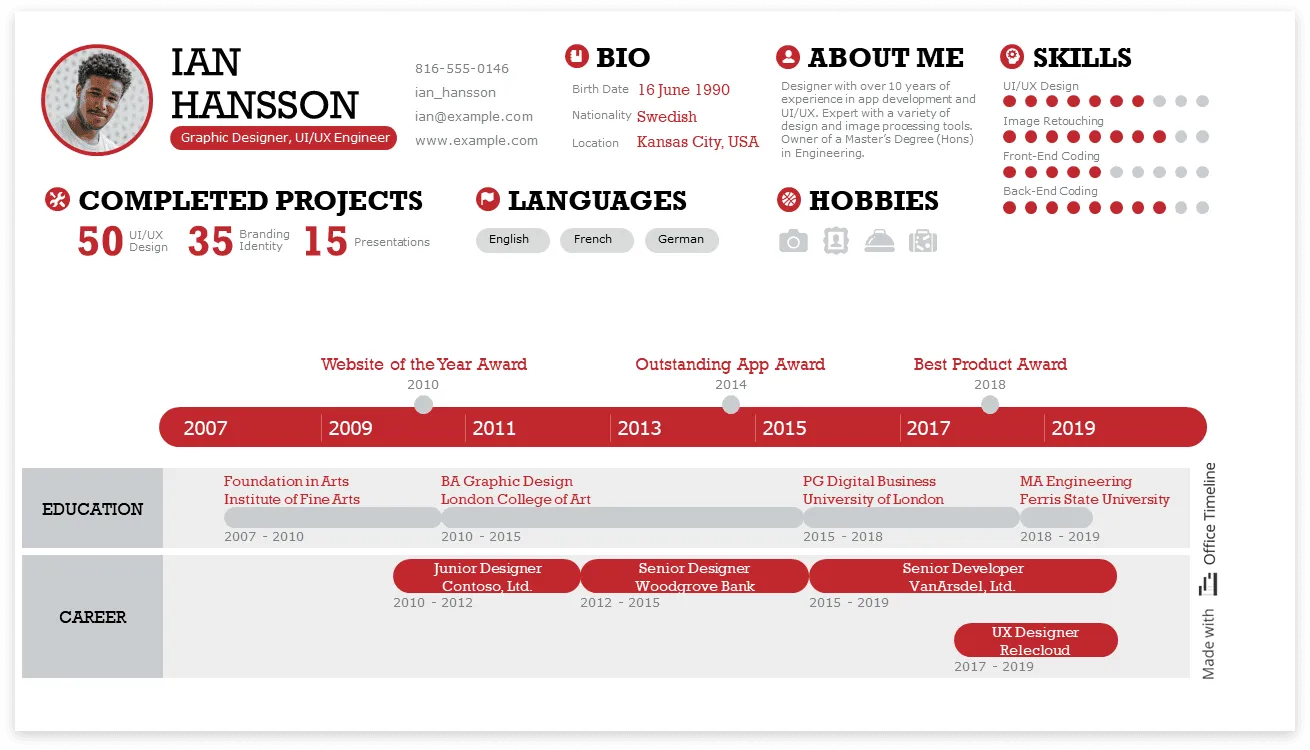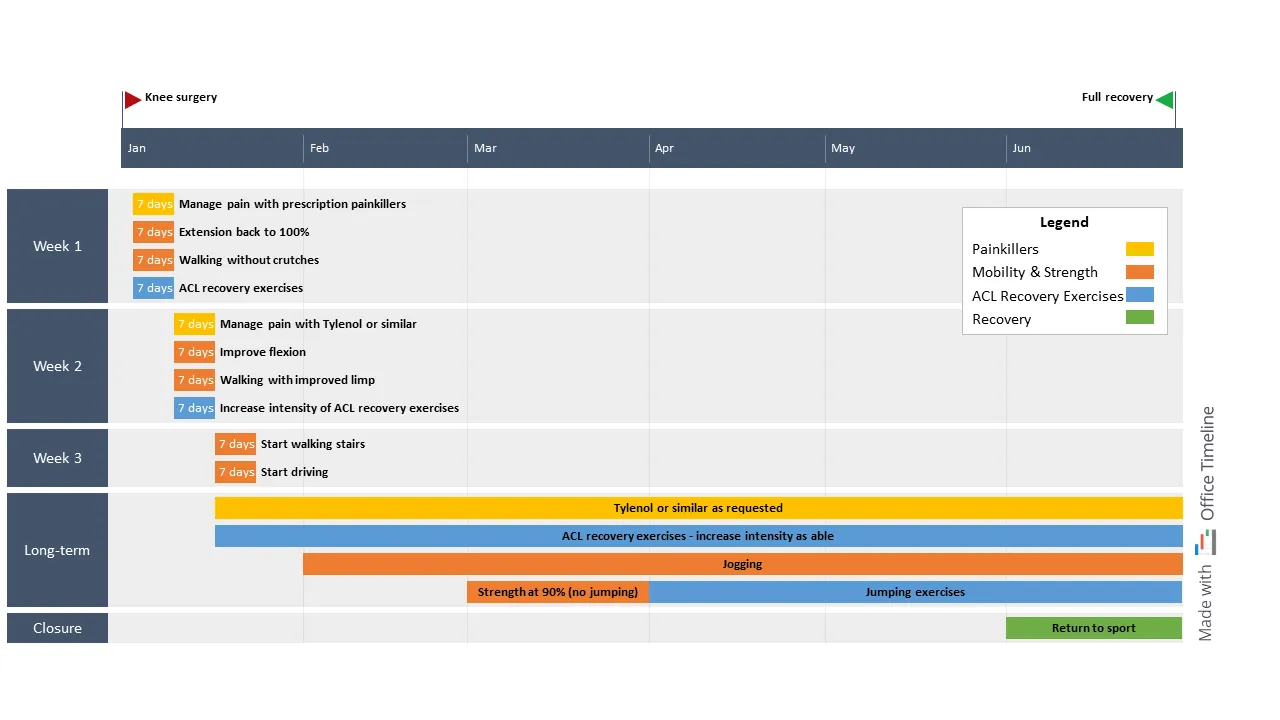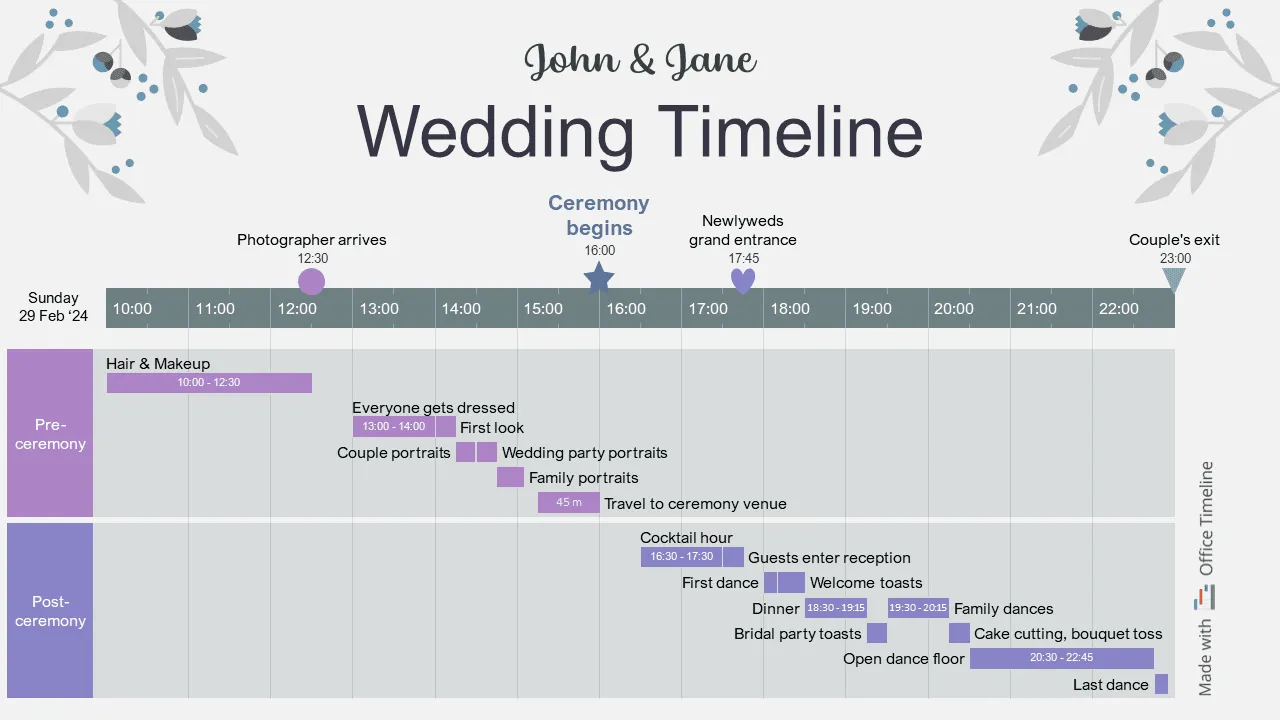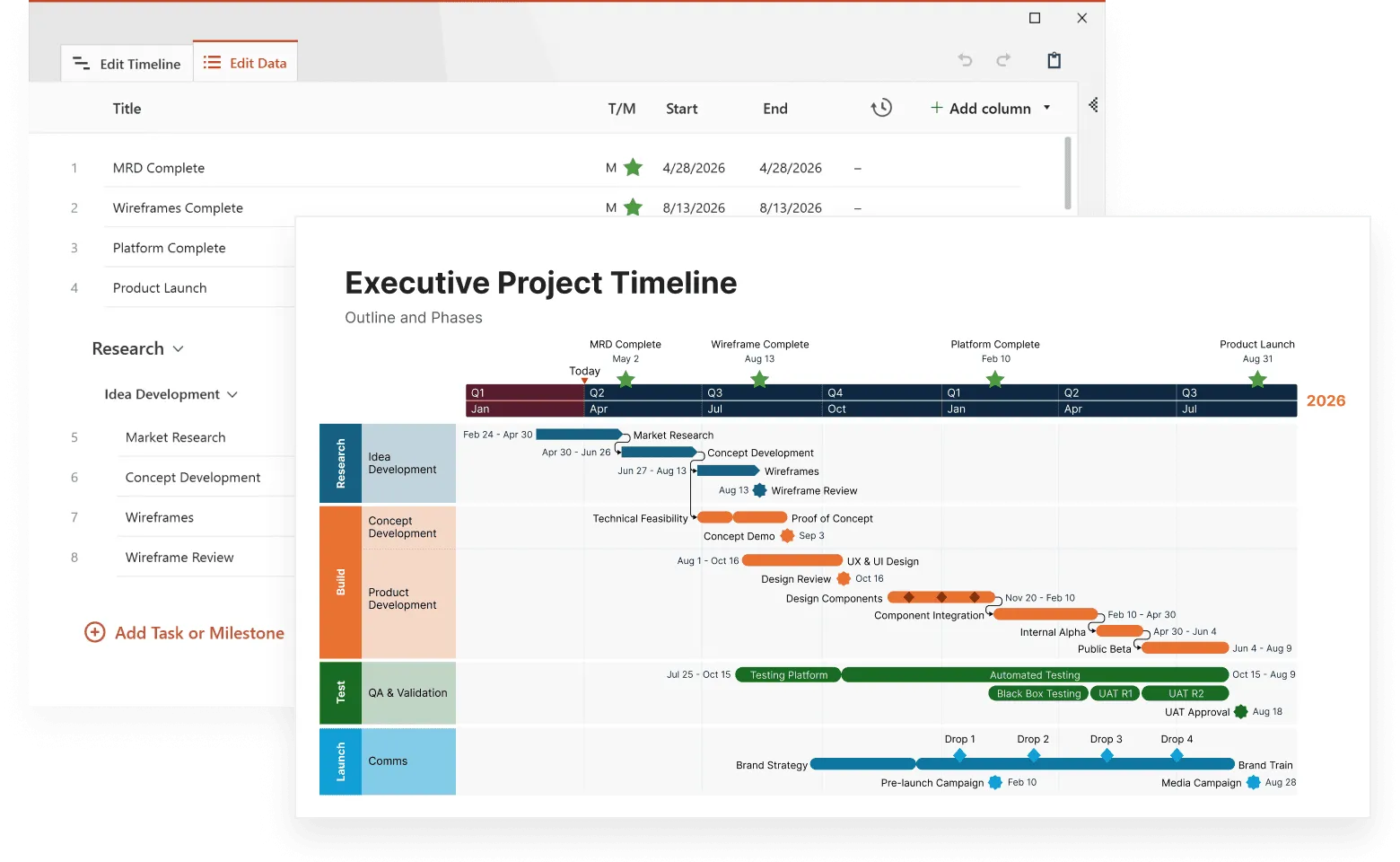Think of a personal timeline as a map of your life's important moments. It shows when things happened and puts your experiences in order. While history books track world events and businesses use timelines for projects, your personal timeline is all about you: your education, your job, your skills, your life events, and your memorable experiences.
In this guide, we'll explore why personal timelines are worth making, how to build one that works for you, and the different ways you can use your timeline in everyday life. You'll learn how timelines help with memory, show patterns in your life, track your progress, and tell your story. We'll also cover the tools you can use, from specialized software to simple DIY methods, and how to keep your timeline updated as your life changes.
See how timelines connect personal, professional, and historical perspectives in our introduction to timelines.
Why personal timelines matter
Your timeline does more than just put dates on a page. It's a tool that helps you make sense of your life in ways you might not expect. When you see your experiences laid out in order, you start to understand your own story better. Here's what makes personal timelines truly useful.
They strengthen your memory
It’s easy to forget when things happened - our memory just isn’t that great with dates. Over time, we often mix up the order of events or think something happened more recently (or longer ago) than it really did. One well-documented phenomenon illustrating this is the telescoping effect, where people perceive recent events as more distant and distant events as more recent than they actually are. This temporal displacement can result in misdating events by several months or even years.
Studies also show that as time passes, memories lose detail and get less accurate, especially as we get older. Aging can influence the specificity and accuracy of these memories, making it challenging to recall precise details without external aids.
Creating a personal timeline can be a reliable reference by documenting events with exact dates and details. It helps keep track of when you finished projects, learned new skills, or reached important goals. It’s a simple way to look back and know exactly what happened and when.
They reveal patterns in your life
Looking at your life events in order helps you spot connections you might miss otherwise. It's like stepping back to see the whole picture instead of just one piece at a time.
Your timeline might show that you got big promotions after learning certain skills. Or you might notice you did your best creative work when living in certain places or with certain routines.
These patterns are gold mines of useful information. Did you get a promotion after each conference you attended? Maybe you should go to more conferences. Do you sleep better when you exercise in the morning? That's a habit worth keeping. Your timeline helps you find what works in your life so you can do more of it.
They track progress toward your goals
Want to turn big dreams into real achievements? A timeline helps break down your goals into steps you can track. Research shows that people who monitor their progress are much more likely to succeed. When you can see how far you've come, you're more motivated to keep going.
Your timeline gives you a visual record of your progress. Learning Spanish? Track when you mastered basic greetings, when you had your first conversation, when you finished each level. Each small win goes on your timeline, showing your steady improvement over time.
This approach works for any goal—fitness milestones, career advancement, learning new skills. Your timeline turns abstract goals into concrete achievements with dates attached, making your progress real and measurable.
They tell your story efficiently
Sometimes you need to share your background quickly and effectively. A timeline lets you do this without forgetting important details. In job interviews, you can walk through your career path with confidence, highlighting your growth and achievements. During performance reviews, your timeline gives you specific examples of your contributions.
How to create your personal timeline
Once you've decided to track your personal history, the next question is how to actually make your timeline. The good news is that you have several options, from specialized software to simple DIY approaches.
Your choice depends on what you need your timeline for, how detailed you want it to be, and how comfortable you are with different tools. Let's look at some practical ways to build your personal timeline.
Digital timeline applications
Software designed specifically for creating timelines offers many advantages:
- Office Timeline: Creates professional-looking timelines in PowerPoint for presentations, reports, and reviews. Great for work timelines that need to impress others.
- Timeline JS: A free tool for making interactive timelines that can include videos, photos, and social media. Perfect for sharing online.
- Tiki-Toki: Makes visually interesting 3D timelines with multimedia. Good for creative projects.
- Preceden: Lets you create layers in your timeline to organize different parts of your life. Helpful for complex life histories.
These programs make formatting easy, visualize your data clearly, and often let you work with others. Many come with ready-made templates for different types of timelines.
Visualize your personal journey
Try Office Timeline for free. Create clean, polished PowerPoint timelines that beautifully capture your milestones and life progress.
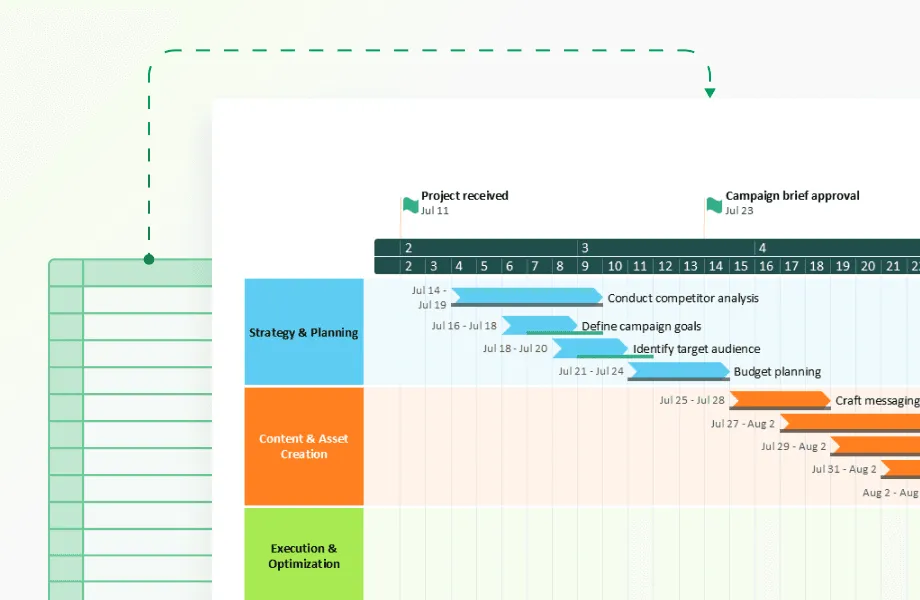
Spreadsheet adaptation
In some cases, you don't even need special software to make a timeline. Regular spreadsheets work well too. Use Excel or Google Sheets to:
- create a list of events in order, use color-coding to group similar items;
- sort and filter your events to see different views (like only work events or only education);
- turn your timeline data into charts or graphs to visualize patterns.
Spreadsheets are flexible and you probably already know how to use them. The downside is they don't look as polished as dedicated timeline apps.
Manual creation methods
Sometimes the old-fashioned way works best. Physical timelines have their own benefits:
- Wall charts: Large timelines you can hang up and see every day. Good for big-picture life planning.
- Journal timelines: Add timeline pages to your regular journal or planner. Keeps everything in one place.
- Scrapbook style: Combine your timeline with photos, tickets, and mementos. Makes your history tangible.
Research shows that creating something with your hands helps you remember information better. The physical act of writing down events or placing items on a timeline can make the information stick in your mind.
Data integration considerations
When pulling information from different sources, keep these things in mind:
- Keep formats consistent: Use the same date format throughout (like MM/DD/YYYY).
- Double-check your facts: Verify dates and details against reliable sources.
- Fill in any gaps: Look for missing time periods and research what happened then.
- Track your sources: Note where you got each piece of information for future reference.
These practices help make your timeline accurate and trustworthy.
Building effective personal timelines
A good timeline needs some basic elements to be truly useful. Let's look at what makes a timeline work well and how to set yours up for success.
Chronological structure
Every timeline needs a clear order. That means putting events in sequence with clear dates. Depending on what you're tracking, you might need to use:
- exact dates (March 15, 2023);
- just month and year (June 2021);
- only the year (2018);
- relative timing (3 months after graduation).
The key is being consistent and making sure anyone looking at your timeline can easily follow the sequence of events.
Thoughtful event selection
Not everything belongs on your timeline. Being selective makes your timeline more useful. Think about including:
- events that show real growth or change;
- experiences that shifted your path or thinking;
- achievements with clear results;
- milestones that took serious effort to reach.
For a work timeline, you'd include your degree, certifications, promotions, and major projects—not everyday tasks or small recognitions. Focus on the events that truly shaped your path.
Information presentation
How you show information matters. A good timeline is easy to understand at a glance but also has details when you need them. Consider using:
- clear descriptions that explain what happened;
- numbers and data that show your growth;
- photos, certificates, or samples of your work;
- links to more information if needed.
Research shows that timelines with both text and visuals help people remember information better than those with text alone. Adding images or charts to your timeline can make it more effective and engaging.
Contextual details
Each event on your timeline needs enough background to explain why it matters. Good notes include:
- what exactly happened or what you accomplished;
- measurable results when possible (like percentages or numbers);
- your specific role if it was a team effort;
- why this event was important for your goals;
- how it connects to other events on your timeline.
These details turn a simple date and title into a meaningful part of your story.
Practical applications of personal timelines
A personal timeline can be a surprisingly useful tool. When you map out the events, changes, and milestones in your life, you create something you can actually rely on.
It helps you remember what happened when, whether you're preparing for a job interview, tracking health goals, using it as a daily planner, or writing down family history. People use timelines to stay organized, reflect on progress, and tell their stories with confidence and clarity.
Daily planner
A personal schedule timeline helps you stay focused and on time during busy days:
Example: July 24 – Election speech day
- 7:30 am: Workout (45 mins)
- 9:30 am: Pick-up and drive to event
- 10:30 am: Rehearsal (1 hour)
- 12:00 pm: Candidate lunch (1 hour)
- 1:45 pm: Speech time
- 5:00 pm: Winner announced
This timeline maps out the entire day in one clear view: activities, breaks, and key moments. It helps you plan ahead, reduce stress, and stay on track during high-pressure events.
Professional development documentation
A work timeline tracks your education, career growth, and skills:
Example:
2007–2010: Foundation in Arts, Institute of Fine Arts
- Built core design skills
- Developed passion for visual storytelling
2010–2012: Junior Designer, Contoso Ltd.
- Created branding and design concepts for client campaigns
- Gained hands-on experience with UI/UX principles
2013: Website of the Year Award
- Recognized for outstanding creativity and usability
2015: Senior Designer, Woodgrove Bank
- Led design projects for digital banking platforms
- Improved customer experience and interface consistency
2018: Best Product Award
- Awarded for contributions to innovative app design
2017–2019: UX Designer, Relecloud
- Oversaw complete UX redesign of flagship product
- Mentored junior designers and enhanced leadership skills
Having these details ready gives you specific talking points for job interviews and reviews. Instead of general statements like "I'm a good leader," you have real examples with numbers to back them up.
Health and wellness tracking
A health timeline tracks your medical history, fitness achievements, and lifestyle changes:
What to track:
- milestone achievements (completing your first 10K run, hitting a weight goal);
- performance metrics (finish times, distances, measurements);
- progress comparisons (how you've improved from previous benchmarks);
- methods that worked (training plans you followed, adherence rates);
- recovery and setbacks (injuries, treatments, how you overcame challenges).
This approach records both what you achieved and how you did it. When you find something that works, your timeline helps you remember exactly what you did so you can repeat your success.
Family history documentation
Family history documentation A family timeline preserves your family's story and connections.
What to document:
- major transitions (immigrations, relocations, career changes);
- specific details that add authenticity (ship names, exact addresses, workplace names);
- family composition at key moments (who was present, ages, relationships);
- how connections were made (community groups, churches, mutual aid societies);
- timeline of adaptation (how quickly they found work, established roots).
For instance, an entry might note: "June 1952: Grandparents moved from Italy to Boston - arrived on SS Constitution with 4 children; lived at 14 Sheafe Street in North End; found work at Martinelli's Bakery within 2 weeks; connected with Italian community through St. Leonard's Church."
This approach saves specific details that might otherwise be lost over time. These small facts (the ship name, the exact address, the bakery) bring your family history to life for future generations.
Maintaining your personal timeline
Setting up your timeline is just the first step; its regular maintenance makes it valuable over time. A timeline that's kept current serves as an accurate record of your experiences and accomplishments. Without updates, even the most detailed timeline becomes outdated and loses its usefulness.
Regular maintenance turns a static document into an evolving record that reflects your ongoing development. Here are some practical approaches to keep your timeline accurate, secure, and adaptable as your circumstances change.
Regular updates
Make it a habit to update your timeline regularly to keep it useful. Before adding new entries, create a simple template that ensures consistent formatting and makes updates quicker.
When adding information, verify its accuracy by cross-checking dates with your electronic calendar, confirming project details against saved files, and validating career milestones with employment records. This consistent approach keeps your timeline reliable and complete as it grows.
Set a reminder to review your timeline after major events, like finishing a big project, completing a course, or reaching a personal goal. Small updates over time are easier than trying to catch up later, and they make sure you don’t forget the details that matter most.
Data security
If you're building a digital timeline, it's worth taking a few simple steps to protect it. Start by setting up automatic weekly backups, ideally to more than one place, like your computer and a cloud service. That way, if something goes wrong, you won’t lose everything.
When you share your timeline, be clear about who can see what. For example, you might be fine with friends seeing your fitness milestones but want to keep career or medical info private. Set permissions accordingly.
If your timeline includes sensitive personal details, take a minute to label those sections and make a note for yourself about how you want to handle them.
And finally, don’t count on one app always being around. Every so often, export your timeline to a common format, like a PDF, text file, or CSV, so you can open it anywhere, even years from now. It’s a small effort that helps you hang on to your personal history for the long run.
Adapting to changing needs
Timeline structures must evolve as your life changes. To keep up with changes make sure to:
- conduct an annual timeline scope review to decide which areas need more detailed documentation;
- implement category adjustments when life circumstances change significantly;
- schedule format migration points at specific technology milestones;
create connection points between your timeline and other personal records.
The lasting value of personal timelines
When you take the time to document your life, you turn memories into something more solid, something you can refer back to.
For example, recording that you finished your master’s degree on May 15, 2023, after logging 437 study hours over two years gives you a clear, detailed record of what you achieved. You’re not relying on guesswork or faded memories.
Success patterns start to show up too. Maybe you notice that every big career step you took came after you completed at least 40 hours of professional development within a three-month window. That’s useful to know, and it’s something you might not realize without seeing it laid out.
Tracking your progress in measurable terms also helps with motivation. If you can see you reached 25% of a language course by March, 50% by June, and 75% by September, that visible progress keeps you moving forward and gives you a sense of your learning pace.
Specialized software, a simple spreadsheet, or even an old-school notebook - whichever method you choose, your timeline becomes a reliable record of how far you’ve come.
It gives you a clear view of the past without depending on memory, helps you set realistic goals based on what actually worked before, and keeps track of the meaningful details that might otherwise fade over time.
Frequently asked questions
Here are answers to the most common questions on personal timelines we hear from people just getting started with timeline creation.
You can start with just 1-2 hours to set up your basic structure and add recent major events. After that, spend about 30 minutes a month adding new events and filling in historical information gradually. The time investment is small compared to the long-term benefits.
This depends on your purpose. For career timelines, focus on relevant education and experience (usually 10-15 years). For health tracking, recent history (3-5 years) is most useful. For family documentation, go as far back as you have reliable information.
A timeline focuses on specific events in chronological order with dates and measurable outcomes. A journal captures thoughts, feelings, and daily experiences in depth. They complement each other—your timeline shows what happened when, while your journal explains how you felt about it.
Include enough detail to make each entry meaningful but not so much that it becomes overwhelming. For most entries, a title, date, and 3-5 bullet points with key information or metrics is sufficient. You can always link to more detailed documentation if needed.
Absolutely! Future timelines are excellent planning tools. They help break long-term goals into manageable steps with specific deadlines. Many people create parallel timelines, one documenting past achievements and another mapping out future goals and milestones.



